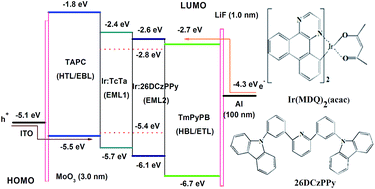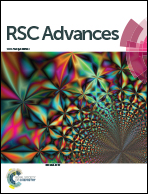High performance red organic electroluminescent devices based on a trivalent iridium complex with stepwise energy levels
Abstract
In this work, electroluminescent (EL) devices with double light-emitting layers (EMLs) having stepwise energy levels were designed and fabricated to improve the EL performances of the red light-emitting trivalent iridium complex bis(2-methyldibenzo[f,h]quinoxaline)(acetylacetonate)iridium(III) [Ir(MDQ)2(acac)]. To broaden the recombination zone and facilitate the balance of carriers on emitter molecules, the widely used p-type material 4,4′,4′′-tri(N-carbazolyl)triphenylamine (TcTa) and bipolar material 2,6-bis(3-(9H-carbazol-9-yl)phenyl)pyridine (26DCzPPy) were chosen as host materials of EML1 and EML2, respectively due to their well matched energy levels. Interestingly, slight decomposition of Ir(MDQ)2(acac) molecules was observed during the deposition of EML, which causes the rapidly decreased brightness at relatively high doping concentration. Finally, a high performance red EL device with maximum current efficiency of 44.76 cd A−1, power efficiency of 40.19 lm W−1, and external quantum efficiency (EQE) of 15.5% was obtained by optimizing the doping concentration of Ir(MDQ)2(acac). Even at a high brightness of 1000 cd m−2 (5.2 V), a current efficiency as high as 40.59 cd A−1 (EQE = 14.4%) can still be retained by the same device.


 Please wait while we load your content...
Please wait while we load your content...